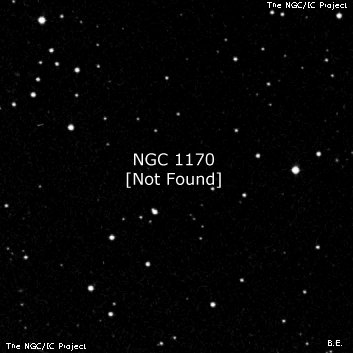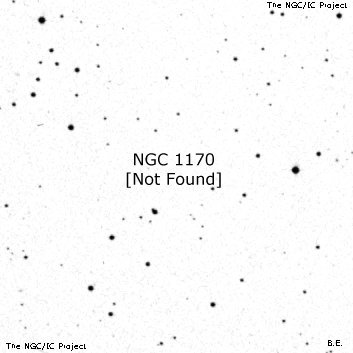NGC/IC Project Restoration Effort
(This is a very very beta version)
NGC1170


Basic Information
Location and Magnitude
Right Ascension: 3:2:26.8
Declination: +27:4:22
Constellation: ARI
Visual Magnitude:
Historic Information
Discoverer: Peirce
Year of discovery: 1869
Discovery aperture: 15.0
Observational
Summary description: eL, dif
Sub-type: NF
Corwin's Notes
=====
NGC 1170 may have been the tail of a comet. It was found by C.S. Pierce at
Harvard on the last day of 1869, and was verified by Joseph Winlock. The
Notes for the observation in Harvard Annals, Vol. 13, Part 1, reads, "J.W. and
C.S.P. independently think the sky generally bright f and a little n of the
comet for 14' or more (several fields according to C.S.P.). [The approximate
place in Table VIII results from comparison with the comet.]" The comment in
square brackets is from the author of the paper, probably J.W. In Table VIII,
the only information is the position 02 54 10, +26 31 (1860), and the Remark,
"Comet 1869 III p neb 2m 31s, a little s."
I haven't yet done the library work to know if the comet's tail stretched off
to the northeast from the head. But the description makes it possible that
this is the correct explanation for this NGC entry.
-----
Using JPL's HORIZONS ephemeris generator in August 2016, I found that the
position of the comet was pretty well verified by the observation. For J2000,
assuming that the observation took place on 30 December 1869 UT at around
04:00 (31 December at 23:00 EST) then the position of the comet would have
been 03 00 06.0, +27 04 15. That would make the position of the nebula
03 02 37, +27 04 for J2000, just 11 seconds larger than the position given by
Pierce and Winlock. Given their description of the size of the nebula, I am
still of the opinion that they actually saw the faint tail of the comet.
Unfortunately, HORIZONS does not give the orientation of the tail. But if we
assume that the tail points away from the sun on the sky as well as in space,
we can work out an approximate orientation. On 31 December, the sun is in
Sagittarius near 18 50.0, -23 00 +-. So the tail, under these assumptions,
would indeed be stretching toward the northeast.
Perhaps a search of the observations of the comet (called "11P/Tempel-Swift-
LINEAR" in modern parlance, "1869 III" in the nomenclature of the day, and
sometimes "1869 c") could confirm or falsify this idea.



